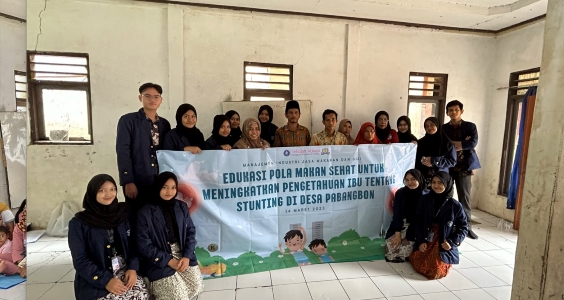IPB University Vocational School Lecturers and Students Reveal Stunting Factors and Their Prevention

Many lecturers and students from the Vocational School (SV) IPB University from the Management of Industrial Food and Nutrition ServicesStudy Program (MIJMG Study Program) conducted outreach activities for pregnant women, lactating mothers, and housewife nutrition in Pabangbon Village, Bogor, West Java. In this activity, the counseling participants received an explanation of the factors that cause stunting and how to prevent it.
"The causes of stunting in toddlers include family economic factors, frequent illnesses or infections, environmental conditions, and low access to nutritious food. Stunting can be prevented by improving the diet of toddlers," said Rosyda Dianah, SKM, MKM, one of the SV IPB University lecturers.
She continued, one of the improvements in the diet for toddlers is by providing complementary food for ASI (MPASI) to provide sufficient energy and nutrient intake for toddlers. In addition, stunting must be prevented by applying the principles of the four pillars of balanced nutrition.
"The long-term effects of stunting include mental retardation, low learning ability, and the risk of chronic disease. Therefore, implementing the four pillars of balanced nutrition is very important," she added.
According to the Ministry of Health (Kemenkes), the four pillars of balanced nutrition consist of consuming a wide variety of foods, living an active lifestyle and exercising, adopting a clean and healthy lifestyle, and maintaining an ideal body weight.
One of the IPB University students, Ratu Aisyah added, apart from breast milk, the food menu that can prevent stunting includes animal ingredients, vegetable ingredients, and fruits. Various variations of processed food can be done so that children under five do not experience saturation in consuming food.
"Several examples of dishes per meal to prevent stunting for babies aged 6-12 months are rice flour milk porridge, avocado puree, minced meat puree, and potato puree. The food menu is easy to practice, paid for, and has affordable raw material prices," he said.
At this counseling, Ratu Aisyah also introduced the Baby Meal Planner application, starting from the steps to download the application to how to use the application. Baby Meal Planner is an application designed by SV IPB University lecturers from the MIJMG Study Program.
"Baby Meal Planner is a food menu planning application for babies aged 6-12 months and 13-24 months. This application can help mothers know the nutritional status of their babies, and plan and make dishes that are diverse, nutritious, balanced, and safe," he said.
In addition to providing counseling in the form of presentation material, IPB University lecturers and students provided pocketbooks to the women of Pabangbon Village which contained information related to stunting and sample menus for toddlers aged 6-12 months.
As the village head of Pabangbon Village, Entin also appealed to the residents of Pabangbon Village to jointly prevent stunting in toddlers by routinely carrying out checks at the integrated health post regarding the growth and development of their children. (*/Rz) (IAAS/BLA)



















